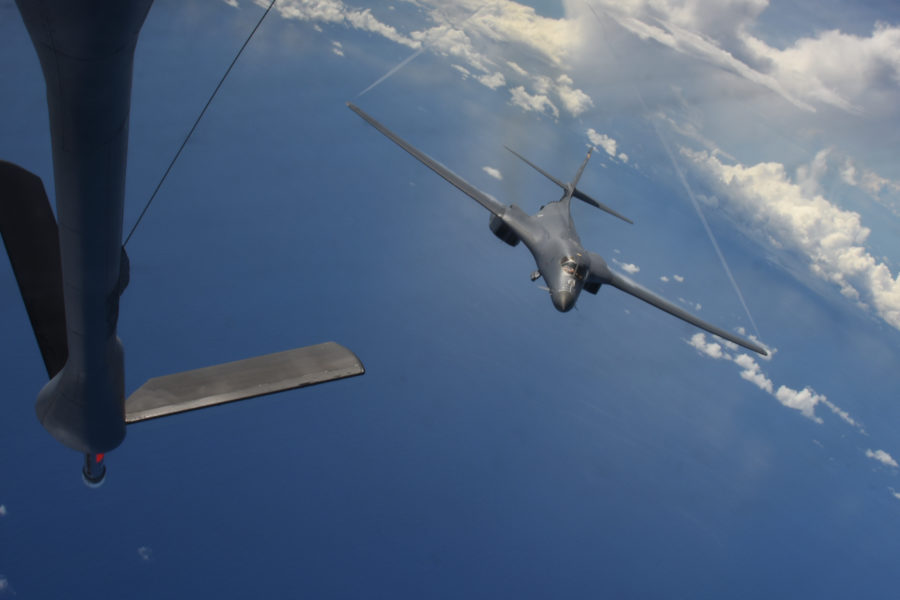China’s growing capabilities and recent boldness in the air domain represent “dangerous and destabilizing” behavior patterns, the Pentagon’s top official on the Indo-Pacific said March 2.
Ely Ratner, assistant secretary of Defense for Indo-Pacific security affairs, discussed how China continues to prod the U.S. and challenge stability in region, even as the U.S. executes a number of cooperation initiatives, as part of a Hudson Institute forum.
“We are seeing a [People’s Liberation Army] that is growing more capable but … growing also more willing to take risk, more willing to use the military instrument of power in a way that we haven’t seen in previous eras,” Ratner said.
This has manifested itself in many recent air encounters between China and the U.S. and its allies, who were operating lawfully in international airspace. Ratner noted an encounter where an Australian aircraft flew through chaff released by a PLA fighter and another incident where the PLA aircraft harassed a Canadian aircraft.
“So here’s an ally of the United States on the other side of the world, helping to enforce U.N. Security Council resolutions against North Korea—resolutions that China voted for—and the PLA is coming out and intercepting these aircraft in a dangerous way, and doing it multiple times,” he said. “And then, of course, you heard from [U.S. Indo-Pacific Command] in December of a similar event of a PLA Navy aircraft coming within 20 feet of a U.S. aircraft, again, quite dangerous, and these aren’t isolated incidents.”
Air incidents aren’t the only issues. Ratner also noted China’s maritime forces pointing a “military-grade laser” at Philippine vessel crews, sending forces to contested parts of the region, and “covert PRC maritime militia land reclamation in the South China Sea.”
He also pointed to the recent Chinese spy balloon incident, saying it was unambiguously meant for surveillance.
“It was equipment that’s inconsistent with weather balloons or whatever they were claiming it was,” Ratner said, noting that it was “part of a broader fleet” that China is utilizing. “We know that these balloons have flown … over more than 40 countries across five continents, so this was not just an isolated incident.”
Patrick Cronin, Asia-Pacific Security Chair for Hudson Institute, asked Ratner how to characterize China’s buildup and the threat of failure in the region.
Ratner pointed to the “strategy documents” released by the Biden administration that describe China as the only power capable of “overthrowing the international order … in a way that runs directly counter to vital U.S. national interests.” It’s China’s “power,” “intent,” and “ambition” that pose such a challenge, he said—though so far, the U.S. has worked with its partners and allies to make sure China’s aggression doesn’t succeed.
“As Deputy Secretary [of Defense Kathleen] Hicks said recently … that when leaders wake up in Beijing, they think today’s not the day,” Ratner said. “Our assessment is that that is true right now, that deterrence is real, deterrence is strong, and we’re doing everything we can to make sure it stays that way.”
Ratner also expressed guarded optimism the U.S. can make it through the 2020s without China invading Taiwan, but it’s a tough scenario. “The challenge is enormous; the capabilities are growing; the ambition is there,” he said. “What we’re doing is reinforcing that deterrence, ensuring that the costs of aggression remain unacceptably high to Beijing—and I think we have a pathway to do that.”
Cronin also introduced the challenge of working with countries in the region through agreements, as with the Philippines, while facing down the specter that the U.S. and China “could come to blows” over such agreements.
Deputy secretary of Defense for South and Southeast Asia Lindsey Ford said the Secretary of Defense and other leaders have addressed this.
“We don’t think that our partners in Southeast Asia, in South Asia, in the Indo-Pacific, have to choose at sort of the strategic level between having a relationship with the United States and having a relationship with China,” she said. “What we’ve focused on is making sure that they have the space to make the choices that they want to make and the ones that they think are in their own sovereign interest.”
Ford also emphasized the many multilateral initiatives undertaken in the region, including a growing trilateral relationship with Japan and Australia and the trilateral initiative with Japan and South Korea—an effort South Korean President Yoon Suk-yeo said March 1 was most important to countering North Korea’s nuclear ambitions.
She particularly highlighted work with the Association of Southeast Asian Nations and the Emerging Leaders initiative.
“This is a way that we begin to bring together emerging leaders on the U.S. side with a lot of our ASEAN counterparts to really sort of strengthen that network going forward,” Ford said. “I think when you look at that all together, you should take away that the picture here is one in which the U.S. and other partners are creating a security architecture that is going to be a lot more resilient.”
